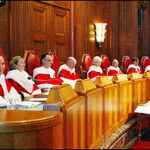Implications of Landmark Aboriginal Title Claim Decision by Supreme Court

Getting approval for projects with environmental implications is always complex. If the proposed projects are on land that an Aboriginal group claims title to, the approval process becomes even more complicated. In a recent decision, the Supreme Court of Canada declared that a First Nation had title to land to which BC had granted a commercial logging licence. Here’s an overview of that decision and its implications for existing and planned projects.
THE CASE
What Happened: For centuries the Tsilhqot’in Nation have (‘Nation’) lived in a remote valley in central BC. In 1983, the province granted a commercial logging licence on land considered by the Nation to be part of its traditional territory. It objected, seeking a declaration prohibiting commercial logging on this land. The original land claim was amended to include a claim for Aboriginal title to the land at issue on behalf of all Tsilhqot’in people. The federal and provincial governments opposed the title claim. The trial court ruled on behalf of the Nation. But the BC Court of Appeal held that the Nation’s claim to title hadn’t been established, so it appealed.
What the Court Decided: The Supreme Court of Canada reversed the decision, ruling that a declaration of Aboriginal title over the area requested should be granted.
The Court’s Reasoning: The Court’s decision focused on two key issues:
Title claim. The Court explained that Aboriginal title flows from ‘occupation’ in the sense of regular and exclusive use of land and such occupation must be: 1) sufficient; 2) continuous (when present occupation is relied on); and 3) exclusive. Determining what constitutes sufficient occupation requires analysis of the Aboriginal culture and practices. The Court added that occupation sufficient to ground Aboriginal title wasn’t confined to specific settlement sites but extends to tracts of land that were regularly used for hunting, fishing or otherwise exploiting resources and over which the group exercised effective control at the time of assertion of European sovereignty.
Here, there was evidence that the parts of the land to which the trial court had found title were regularly used by the Nation, which supports the conclusion of sufficient occupation. The proximity between sites for which evidence of recent occupation was provided and those for which direct evidence of historic occupation existed also support an inference of continuous occupation. And the evidence indicated that before assertion of European sovereignty, the Nation had repelled other people from this land and demanded permission from outsiders who wished to pass over it, demonstrating that the Nation members treated the land as exclusively theirs.
Duty to consult. When a Nation has Aboriginal title to land, it has the exclusive right to decide how the land is used and to benefit from those uses, provided that these uses are consistent with the group nature of the interest and the enjoyment of the land by future generations. Before establishment of title, the Crown is required to consult in good faith with any Aboriginal groups asserting title to the land about proposed uses of it and, if appropriate, accommodate the interests of such groups. After Aboriginal title has been established, the Crown must not only comply with its procedural duties, but also justify any incursions on Aboriginal title lands by:
- Demonstrating that the incursion is necessary to achieve the government’s goal;
- Going no further than necessary to achieve this goal; and
- Showing that the benefits that may be expected to flow from the goal aren’t outweighed by adverse effects on the Aboriginal interest.
Here, BC issued licences affecting the land in 1983 and onwards before title was declared. At that time, the Crown was required to consult the Nation on uses of the lands and accommodate its interests. But the province did neither and thus breached its duty to the Nation [Tsilhqot’in Nation v. BC, [2014] SCC 44 (CanLII), June 26, 2014].
ANALYSIS
This decision has widely been described as ‘landmark’ because it’s the first case in which the Court confirmed aboriginal title over specific areas of land. Many experts believe that this decision will have significant and long-term implications for both proposed and existing projects on title lands.
For example, as to proposed projects, the Court affirmed that economic development initiatives, including forestry, mining and hydroelectric developments, may justify infringement on Aboriginal title. But the Court stressed that the focus must be on the economic value of the project relative to the detrimental effects on the Aboriginal rights holder and on whether the project would substantially deprive future generations of the benefit of the land.
After title has been established, the Court explained, ‘If the Crown begins a project without consent prior to Aboriginal title being established, it may be required to cancel the project upon establishment of the title if continuation of the project would be unjustifiably infringing.’ So the government may be required to cancel an already approved project if its continuation would unjustifiably infringe on the Aboriginal title. The good news for project developers is that under the test spelled out in this decision, proving Aboriginal title is still very difficult. But to avoid getting tangled in costly litigation over title claims and infringement on such title, the best course may be to get the group’s consent to your project in advance.